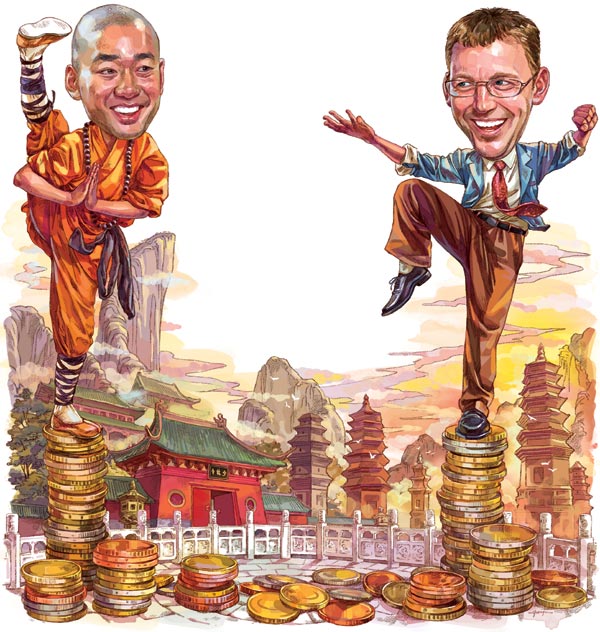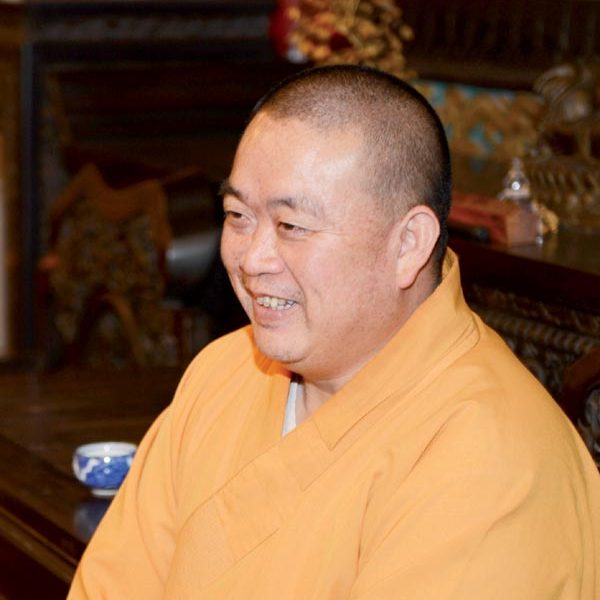Enlightenment is not always free, it can be for hire too. In Shaolin Temple, Buddhism has been commercialised for altruistic reasons. More giant corporations and leaders are seeking them out to learn the secret martial art and ancient wisdom to apply in the modern world. Apparently applying Shaolin kung fu as art of war by these corporations for commercialism.

In the ancient mountain fastness of Shaolin Temple, behind the closed doors of a Buddhist sanctum, Abbot Shi Yongxin holds court from a lacquered wooden chair carved with dragons.
At his left hand, a trio of warrior monks stands attentively, 1,500 years worth of secret skills and kung fu technique trained into their loose limbs.
There is something of the snake and tiger in their poise and posture, of the crane and the monkey in the way they move.
Amid the trappings of the past in the ornate receiving room, the abbot and his followers seem like throwbacks to China's age of legend, remnants of a bygone era.
The spell is broken by an electronic jingle.
Shi, the 30th spiritual leader of the ancient order, pulls a smartphone out of his robes. He flips it open briefly to scan the screen, grunts and quickly makes the handset disappear again.
The 21st century has come to the famed temple at the heart of Chinese kung fu, bringing with it a new wave of foreign interest from an unlikely quarter, and a growing debate domestically about what this means for the culturally iconic Chan Buddhist institution.
"We pursue a peaceful and simple life," Shi says. "Our ultimate goal is to achieve the enlightenment of Buddha and to help others achieve enlightenment."
But enlightenment isn't always free at Shaolin Temple, not that this matters to a new breed of acolyte prepared to pay for the kung fu wisdom the order offers.
They are CEOs of multimillion-dollar companies, foreign businesspeople from many fields, and motivated professionals willing to fork out about $800 a month to learn and live at Shaolin.
While this phenomenon is part of a business model that is helping secure Shaolin's future, some believe it is also part of a malaise that jeopardizes its ties to the past.
Every day, thousands of tourists throng the temple grounds, once a quiet retreat for 13 famous warrior monks who, legend has it, took down a despotic warlord and his army during the Tang Dynasty (AD 618-907).
In their time, much of the mystery surrounding Shaolin pertained to the arcane, the closely guarded mental and physical abilities that approach the mystical in the telling.
These days the temple is still cloaked in secrecy, but that relates largely to a veil of corporate confidentiality maintained by a separate business entity.
CTS Songshan Shaolin Culture Tourism Company, which collects an admission fee of 100 yuan ($16) a person to enter the scenic park that people making the pilgrimage to the temple must pass through, declined to provide China Daily with visitor numbers or annual revenue.

Shi Yongxin. [China Daily]
Grizzled masters endure the daily invasion with stoic expressions. Shaven-headed novice monks talk loudly on smartphones, or sell incense and trinkets, or access the Wi-Fi now available in the ancient buildings.
Shaolin-brand medical books are sold on Taobao, China's e-commerce equivalent of Amazon, and Buddhist disciples can now avoid the trek up Songshan mountain by paying to study at Shaolin by correspondence on the Internet.
Since 2010, the temple has had an online social media presence on Facebook equivalents such as Sina Weibo, and now boasts more than 150,000 followers. There is also a gaming app being developed to teach users kung fu on their mobile phones.
Shi, one of the first Chinese monks to gain an MBA, says Shaolin's business interests have been set up to support and preserve its 1,500-year-old culture.
"We have entered a commercialized society ... so people tend to evaluate things from the angle of commercialization," Shi says. "But you need to look at what is behind the business practice. Some people do business so they can survive, and some do it to seek fortune. Shaolin Temple just wants to survive, to practice Buddhism."
In March, executives from US tech giants Google and Apple joined the ranks of prominent global businesspeople to have received Shi's wisdom.
Members of the China Entrepreneurs Club, a group that consists of 46 leaders of the country's top private companies, also spoke with the abbot in a closed-door session this year at a conference themed "self cultivation of entrepreneurs".
These kinds of engagements are part of the reason why not everyone is convinced Shaolin's growing commercial interests are entirely altruistic, including outspoken Chinese netizens and some prominent martial arts masters from rival schools.
In a shaded courtyard, kung fu masters flow through fighting forms with a sinuous, otherworldly grace.
A group of students look on as the shaven-headed monks demonstrate the basic stances of wushu, the backbone of Shaolin's fighting style, made famous worldwide by the moviemakers of Hong Kong and Hollywood.
These eager pupils are African, American and European. And while some have made the pilgrimage to Shaolin seeking the fabled martial prowess that will stop an enemy's heart with a single blow, just as many say they have come looking for a professional edge.
As recently as a decade ago, foreign students were uncommon at Shaolin.
But, as Demina Masoula knows first hand, things have changed.
The 43-year-old business and marketing consultant is part of a group from Greece that has come to study at Shaolin for about two weeks.
An insurance company executive and an engineer for a multinational company practice nearby while Masoula takes a breather from the demanding 4:30 am to 9 pm daily training regime.
She believes the principles inherent in the kung fu she is learning can be applied to her professional life. It is a way, she says, of honing business instincts to react like muscle memory.
"In business, you have to be flexible, you have to find new paths and change. You have to see a crisis and avoid it. Kung fu teaches you to be fluid, like water, because everything in kung fu flows and stagnation is bad."
http://www.china.org.cn/business/2014-08/25/content_33329466.htm?